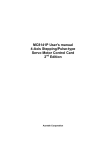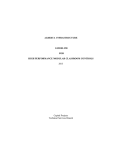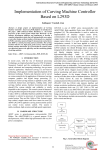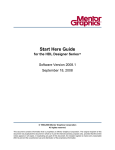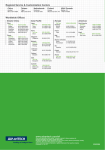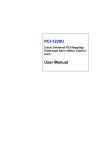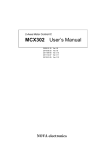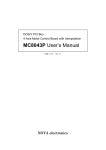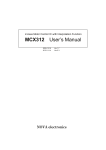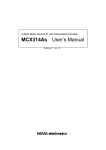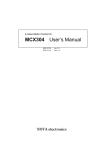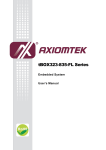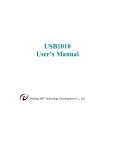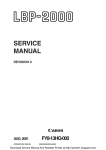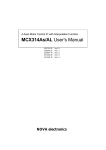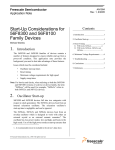Download PCM-3240 User Manual
Transcript
PCM-3240 4-Axis Stepping/Pulse-type Servo Motor Control Card User Manual Copyright This documentation and the software included with this product are copyrighted 2005 by Advantech Co., Ltd. All rights are reserved. Advantech Co., Ltd. reserves the right to make improvements in the products described in this manual at any time without notice. No part of this manual may be reproduced, copied, translated or transmitted in any form or by any means without the prior written permission of Advantech Co., Ltd. Information provided in this manual is intended to be accurate and reliable. However, Advantech Co., Ltd. assumes no responsibility for its use, nor for any infringements of the rights of third parties which may result from its use. Acknowledgments PC-LabCard is a trademark of Advantech Co., Ltd. IBM and PC are trademarks of International Business Machines Corporation. MS-DOS, Windows®, Microsoft® Visual C++ and Visual BASIC are trademarks of Microsoft® Corporation. Intel® and Pentium® are trademarks of Intel Corporation. Delphi and C++Builder are trademarks of Inprise Corporation. Part No. 2003324000 1st Edition Printed in Taiwan PCM-3240 User Manual ii July 2005 Product Warranty (2 years) Advantech warrants to you, the original purchaser, that each of its products will be free from defects in materials and workmanship for two years from the date of purchase. This warranty does not apply to any products which have been repaired or altered by persons other than repair personnel authorized by Advantech, or which have been subject to misuse, abuse, accident or improper installation. Advantech assumes no liability under the terms of this warranty as a consequence of such events. Because of Advantech’s high quality-control standards and rigorous testing, most of our customers never need to use our repair service. If an Advantech product is defective, it will be repaired or replaced at no charge during the warranty period. For out-of-warranty repairs, you will be billed according to the cost of replacement materials, service time and freight. Please consult your dealer for more details. If you think you have a defective product, follow these steps: 1. Collect all the information about the problem encountered. (For example, CPU speed, Advantech products used, other hardware and software used, etc.) Note anything abnormal and list any onscreen messages you get when the problem occurs. 2. Call your dealer and describe the problem. Please have your manual, product, and any helpful information readily available. 3. If your product is diagnosed as defective, obtain an RMA (return merchandize authorization) number from your dealer. This allows us to process your return more quickly. 4. Carefully pack the defective product, a fully-completed Repair and Replacement Order Card and a photocopy proof of purchase date (such as your sales receipt) in a shippable container. A product returned without proof of the purchase date is not eligible for warranty service. 5. Write the RMA number visibly on the outside of the package and ship it prepaid to your dealer. iii CE This product has passed the CE test for environmental specifications when shielded cables are used for external wiring. We recommend the use of shielded cables. This kind of cable is available from Advantech. Please contact your local supplier for ordering information. Technical Support and Assistance Step 1. Visit the Advantech web site at www.advantech.com/support where you can find the latest information about the product. Step 2. Contact your distributor, sales representative, or Advantech's customer service center for technical support if you need additional assistance. Please have the following information ready before you call: - Product name and serial number - Description of your peripheral attachments - Description of your software (operating system, version, application software, etc.) - A complete description of the problem - The exact wording of any error messages Packing List Before setting up the system, check that the items listed below are included and in good condition. If any item does not accord with the table, please contact your dealer immediately. • PCM-3240 card • Companion CD-ROM (DLL driver included) • User’s Manual Safety Precaution - Static Electricity Follow these simple precautions to protect yourself from harm and the products from damage. 1. To avoid electrical shock, always disconnect the power from your PC chassis before you work on it. Don't touch any components on the CPU card or other cards while the PC is on. 2. Disconnect power before making any configuration changes. The sudden rush of power as you connect a jumper or install a card may damage sensitive electronic components. PCM-3240 User Manual iv Contents Chapter 1 Introduction ..................................................... 2 1.1 1.2 1.3 1.4 Chapter Chapter Features ............................................................................. 2 Applications ...................................................................... 5 Installation Guide .............................................................. 5 Accessories........................................................................ 6 2 Installation ....................................................... 8 2.1 2.2 Unpacking ......................................................................... 8 Driver Installation ............................................................. 9 2.3 Hardware Installation ..................................................... 11 Figure 2.1:The Setup Screen of Advantech Automation Software ........................................................... 10 Figure 2.2:Different Options for Driver Setup ............ 10 3 Signal Connections ........................................ 14 3.1 3.2 I/O Connector Pin Assignments...................................... 14 Location of Jumpers and DIP switch .............................. 14 3.3 Output Pulse Definition (nP+P, nP+N, nP-P, nP-N)....... 21 3.4 General Purpose Output .................................................. 23 3.5 Over Traveling Limit Switch Input (nLMT+, nLMT-)... 24 3.6 Dec./Instantaneous Stop Switch Input (nIN1 ~ 3) .......... 25 3.7 General Purpose Input for Servo Drives ......................... 26 3.8 Encoder Input .................................................................. 27 3.2.1 Base Address Selection (SW1) .................................... 15 Table 3.1:Module I/O Addresses (SW1) ..................... 15 Table 3.2:PC bus Address Control .............................. 15 Figure 3.1:I/O Conn. Pin Assig. for the PCM-3240 .... 16 Table 3.3:PCM-3240 I/O Conn. Signal Desc. (part 1) 17 Table 3.3:PCM-3240 I/O Conn. Signal Desc. (part 2) 18 Table 3.3:PCM-3240 I/O Conn. Signal Desc. (part 3) 19 Figure 3.2:Location of Jumpers and DIP switch ......... 20 Figure 3.3:Output Signal Loop for Drive Pulses ......... 21 Table 3.4:Jumper Table of JP1~4 ................................ 22 Figure 3.4:Photo coupler input interface ..................... 22 Figure 3.5:Line driver input interface .......................... 23 Figure 3.6:Circuit Diag. for General Purposed Output 23 Figure 3.7:Circuit Diagram for Movement Limit Input Signals .............................................................. 24 Figure 3.8:Example of photo sensor used in the limit input signal ................................................................ 24 Figure 3.9:Circuit Diagram of Deceleration/Instantaneous Stop Input Signal ................................... 25 Figure 3.10:Input Signal for Servo Motor ................... 26 Figure 3.11:Circuit Diagram of Encoder Feedback ..... 27 v Table of Contents Figure 3.12:Example of the connection diagram of differential-output line driver ................................... 28 Figure 3.13:Example of the connection for open collector output encoder ................................................. 28 3.9 External Pulse Control Input (nEXOP+, nEXOP-)......... 29 3.10 Emergency Stop Input (EMG) ........................................ 30 3.11 3.12 External Power Input (VEX)........................................... 30 Interrupt Setting............................................................... 31 3.13 Connection Examples for Motor Drivers ........................ 32 3.14 3.15 Figure 3.14:Circuit Diagram of the External Drive Operation Signals ..................................................... 29 Figure 3.15:Example of connecting to Jog .................. 29 Figure 3.16:Circuit Diagram of Emergency Stop Input Signal ............................................................... 30 Table 3.5:Jumper table of JP5 ...................................... 30 Figure 3.17:Circuit Diagram of Interrupt Setting ........ 31 3.13.1 Connection to Step Motor Drivers ............................... 32 Figure 3.18:Example of connecting to KR515M drive 32 Figure 3.19:Example of Conn. to UPK Step Drive ..... 33 3.13.2 Connection to Servo Motor Drivers ............................. 34 Figure 3.20:Connection Example to MINAS X series AC servo motor drive ............................................. 34 Field Wiring Considerations ........................................... 35 I/O Signal Timing............................................................ 36 3.15.1 Power On RESET ........................................................ 36 Figure 3.21:Timing diagram of Power On RESET ..... 36 3.15.2 Individual Axis Driving ............................................... 36 Figure 3.22:Timing diagram of Indivd. Axis Driving . 36 3.15.3 Interpolation Driving ................................................... 36 Figure 3.23:Timing diagram of Interpolation Driving . 36 3.15.4 Input Pulse Timing ....................................................... 37 Figure 3.24:Timing diagram of Quadrature Pulse of Encoder Input ....................................................... 37 Figure 3.25:Timing diag. of UP/DOWN Pulse Input .. 37 3.15.5 Instantaneous Stop Timing .......................................... 37 Figure 3.26:Timing diagram of External Instantaneous Stop Signal ....................................................... 37 Figure 3.27:Timing diagram of Instantaneous Stop Instruction ........................................................... 38 3.15.6 Deceleration Stop Timing ............................................ 38 Figure 3.28:Timing diagram of External Deceleration/ Stop Signal ....................................................... 38 Figure 3.29:Timing diagram of Deceleration/Stop Instruction ........................................................... 38 PCM-3240 User Manual vi Appendix A Specifications ................................................. 40 A.1 A.2 A.3 A.4 A.5 A.6 Axes................................................................................. 40 Digital Input/Output ........................................................ 41 Input Pulse for Encoder Interface.................................... 42 External Signals Driving ................................................. 42 Other Functions ............................................................... 43 General ............................................................................ 43 Appendix B Block Diagram ............................................... 46 Appendix C Register Structure and Format.................... 48 C.1 C.2 Overview ......................................................................... 48 I/O Port Address Map ..................................................... 48 C.3 C.4 MCX314AS WRITE Registers: WR0 ~ WR7 ................ 55 Clear Interrupt Register: CLRINT .................................. 55 C.5 Pulse Generator Mode/Status Register: PGM/PGSTA ... 55 C.6 C.7 MCX314AS READ Registers: RR0 ~ RR7 .................... 57 Interrupt Status Register: INTSTA ................................. 58 C.8 C.9 Interrupt Channel Selection Register .............................. 58 Output Channel Selection Register ................................. 59 Table C.1:PCM-3240 WRITE Register Function ........ 49 Table C.2:PCM-3240 WRITE Register Format .......... 51 Table C.3:PCM-3240 READ Register Function ......... 52 Table C.4:PCM-3240 READ Register Format ............ 54 Table C.5:Clear Interrupt Register: CLRINT - Write BASE +10 ........................................................ 55 Table C.6:Pulse Generator Mode/Status Register: PGM/ PGMSTA - Write/Read BASE +14 ................. 56 Table C.7:Pulse Generator Mode - PGMn3 ................. 56 Table C.8:Pulse Generator Signal Connection Mode .. 57 Table C.9:Driving Axis for Software Programmable Mode ................................................................ 57 Table C.10:Interrupt Status Register: INTSTA - Read BASE +10 ........................................................ 58 Appendix D Wiring with Third-Party Motor Drivers .... 62 Figure D.1:Wiring Diagram with Mitsubishi MR-J2S Series Motor Driver ............................................. 62 Figure D.2:Wiring Diagram with Oriental LIMO EZMC Series Motor Driver ......................................... 63 Figure D.3:Wiring Diagram with Panasonic MINAS-A Series Motor Driver ......................................... 64 Figure D.4:Wiring Diagram with Yaskawa SGDM Series Motor Driver .................................................... 65 vii Table of Contents PCM-3240 User Manual viii CHAPTER 1 2 Introduction Chapter 1 Introduction The PCM-3240 4-Axis Stepping/Pulse-type Servo Motor Control Card is designed for general-purpose extreme motion applications. The PCM3240 is a high-speed 4-Axis motion control card for the standard PC/104 interface that simplifies stepping and pulse-type servo motor control, giving you added performance from your motors. The card’s intelligent NOVA MCX314AS-motion ASIC builds in a variety of motion control functions, such as 2/3-axis linear interpolation, 2axis circular interpolation, T/S-curve acceleration/deceleration rate and more. In addition, the PCM-3240 performs these motion control functions without processor load during driving. For advanced applications, we supply Windows DLL drivers and user-friendly examples to decrease your programming load. Moreover, through a free bundled PCM-3240 motion utility, it could be your best choice of embedded motion control system. 1.1 Features The Advantech PCM-3240 provides users with the most requested motor control functions as seen below: • Independent 4-axis motion control • Support hand wheel and jog function • 2/3-axis linear interpolation function • 2-axis circular interpolation function • Continuous interpolation function • Programmable T/S-curve acceleration and deceleration • Up to 4MPPS pulse output for each axis • Two pulse output types: Up/Down or Pulse/Direction • Up to 1 MHz encoder input for each axis • Two encoder pulse input types: A/B phase or Up/Down • Position management and software limit switch function • Free Motion Utility bundled for configuration and diagnosis The Advantech PCM-3240 offers the following main features: PCM-3240 User Manual 2 Individual Control for 4 Axes Each of the four axes has identical function capabilities, and is controlled by the same method of operation with constant speed, trapezoidal or S-curve driving. Programmable T/S-curve Acceleration and Deceleration Each of four axes can be preset individually with S-curve or trapezoidal acceleration/deceleration rates. When using S-curve acceleration to control driving speed, output pulse is generated in parabolic-shaped acceleration or deceleration curves, and the triangular curve phenomenon will not occur through the NOVA MCX314AS-motion ASIC design concept. Linear and Circular Interpolation Any two or three axes can be selected to execute linear interpolation driving and any two axes can be selected to execute circular arc interpolation control. The interpolation speed range is from 1 PPS to 4 MPPS. Powerful position management function Each axis is equipped with a 32-bit logical position counter and a 32-bit real position counter. The logical position counter counts the axis’ pulse output number and the real position counter is recorded with the feedback pulse from the outside encoder or linear scale. Speed Control The speed range of the pulse output is from 1PPS to 4MPPS for constant speed, trapezoidal or S-curve acceleration/deceleration driving. The accuracy of the frequency of the pulse output is less than +/- 0.1% (at CLK=16 MHz). The speed of driving pulse output can be freely changed during the driving. Bit Pattern Interpolation Any 2 or 3 axes can be selected to perform the bit pattern interpolation, and the interpolation data is calculated by CPU; CPU writes the bit data into MCX314AS. Then, MCX314AS outputs pulses continuously at the preset driving speed. So, the user can process any interpolation curve by this mode. Continuous Interpolation Different interpolation methods can be used continuously, for example: Linear interpolation!Circular interpolation!Linear interpolation. The maximum driving speed of performing continuous interpolation is 2 MPPS. 3 Chapter 1 Constant Vector Speed Control This function performs a constant vector speed. During the interpolation driving, MCX314AS can set a 1.414 times pulse cycle for 2-axis simultaneous pulse output, and a 1.732-time pulse cycle for 3-axis simultaneous pulse output that keep the constant speed during driving. Position Control Each axis has a 32-bit logic position counter and a 32-bits real position counter. The logic position counter counts the output pulse numbers, and the real position counter counts the feedback pulse numbers from the external encoder or linear scale. Compare Register and Software Limit Each axis has two 32-bit compare registers for logical position counter and real position counter. The comparison result can be read from the status registers. The comparison result can be notified by an interrupt signal. These registers can be also functioned as software limits. Driving by External Signal It is possible to control each axis by external signals. The +/- direction fixed pulse driving and continuous driving can be also performed through the external signals. This function is used for JOG or teaching modes, and will share the CPU load. Input/ Output Signal Each axis has 4 points of input signals to perform deceleration and stop in driving. These input signals are for high-speed near-by home search, home search and z-phase search during the home returning. Each axis is with four output points for general output. Servo Motor Feedback Signals Each axis includes input pins for servo feedback signals such as in-positioning, close loop positioning control and servo alarm. Interrupt Signals Interrupt signals can be generated when: (1). The start / finish of a constant speed drive during the trapezoidal driving, (2). The end of driving, and (3). The compare result once higher / lower the border-lines of the position counter range. An interrupt signal can be also generated during the interpolation driving. PCM-3240 User Manual 4 Real Time Monitoring During the driving, the present status such as logical position, real position, drive speed, acceleration / deceleration, status of accelerating / decelerating and constant driving can be read. 1.2 Applications • Precise X-Y-Z position control • Precise rotation control • Packaging and assembly equipment • Machine control with up to 4 axes • Semiconductor pick and place and testing equipment • Other stepping/pulse-type servo motor applications 1.3 Installation Guide Before you install your PCM-3240 card, please make sure you have the following necessary components: • PCM-3240 DAS card • PCM-3240 User Manual • Driver Software: Advantech PCM-3240 DLL drivers (Included in the companion CD-ROM) • Motion Utility: Advantech PCM-3240 Motion Utility (Included in the companion CD-ROM) • Wiring cable: 2 x PCL-10150 or PCL-12150 (for ADAM-3952) • Wiring board: ADAM-3950 or ADAM-3952 • Personal computer or workstation with a PC/104 slot After you have got the necessary components and maybe some accessories for enhanced operation of your Motion card, you can then begin the Installation procedures. 5 Chapter 1 1.4 Accessories Advantech offers a complete set of accessory products to support the PCM-3240 card. These accessories include: Wiring Cables • PCL-10150 IDC 50-pin flat cable. • PCL-12150 IDC 50-pin to SCSI 50-pin flat able. PCL-12150 is specially designed to work with wiring board ADAM-3952 Wiring Boards • ADAM-3952 The ADAM-3952 is a 50-pin SCSI wiring terminal module for DIN-rail mounting. This terminal module can allow easy yet reliable access to individual pin connections for the PCM-3240 card. • ADAM-3950 ADAM-3950 is a IDC 50-pin general purpose wiring terminal module for DIN-rail mounting. PCM-3240 User Manual 6 CHAPTER 2 2 Installation This chapter gives users a package item checklist, proper instructions about unpacking and step-by-step procedures for both driver and card installation. Chapter 2 Installation 2.1 Unpacking After receiving your PCM-3240 package, please inspect its contents first. The package should contain the following items: " PCM-3240 card " Companion CD-ROM (DLL driver included) " User Manual The PCM-3240 card harbors certain electronic components vulnerable to electrostatic discharge (ESD). ESD could easily damage the integrated circuits and certain components if preventive measures are not carefully paid attention to. Before removing the card from the antistatic plastic bag, you should take following precautions to ward off possible ESD damage: • Touch the metal part of your computer chassis with your hand to discharge static electricity accumulated on your body. Or one can also use a grounding strap. • Touch the antistatic bag to a metal part of your computer chassis before opening the bag. • Take hold of the card only by the metal bracket when removing it out of the bag. After taking out the card, first you should: • Inspect the card for any possible signs of external damage (loose or damaged components, etc.). If the card is visibly damaged, please notify our service department or our local sales representative immediately. Avoid installing a damaged card into your system. Also pay extra caution to the following aspects to ensure proper installation: Avoid physical contact with materials that could hold static electricity such as plastic, vinyl and Styrofoam. PCM-3240 User Manual 8 Whenever you handle the card, grasp it only by its edges. DO NOT TOUCH the exposed metal pins of the connector or the electronic components. Note Keep the antistatic bag for future use. You might need the original bag to store the card if you have to remove the card from PC or transport it elsewhere. 2.2 Driver Installation We recommend you to install the driver before you install the PCM-3240 card into your system, since this will guarantee a smooth installation process. The 32-bit DLL driver Setup program for the card is included on the companion CD-ROM that is shipped with your DAS card package. Please follow the steps below to install the driver software: Step 1: Insert the companion CD-ROM into your CD-ROM drive. Step 2: The Setup program will be launched automatically if you have the autoplay function enabled on your system. When the Setup Program is launched, you’ll see the following Setup Screen. Note If the autoplay function is not enabled on your computer, use Windows Explorer or Windows Run command to execute SETUP.EXE on the companion CD-ROM. 9 Chapter 2 Figure 2.1: The Setup Screen of Advantech Automation Software Step 3: Select the PCM-3240 DLL Drivers option. Step 4: Select the proper Windows OS option according to your operating system. Just follow the installation instructions step by step to complete your DLL driver setup. Figure 2.2: Different Options for Driver Setup Step 5: Then setup the PCM-3240 Motion Utility automatically. For further information on driver-related issues, an online version of Software Manual is available by accessing the following path: Start/Programs/Advantech PCM-3240 Driver The example source codes could be found under the corresponding installation folder such as the default installation path: \Program Files\Advantech\PCM3240\Examples PCM-3240 User Manual 10 2.3 Hardware Installation Note Note 2: Make sure you have installed the driver first before you install the card (please refer to 2.2 Driver Installation) A DOS example can be found at CD_drive:\DOS\PCM\PCM3240\ After the DLL driver installation is completed, you can now go on to install the PCM-3240 card in any PC/104 connector on your computer. It is suggested that you refer to the computer user manual or related documentation if you have any doubts. Please follow the steps below to install the card on your system. Step 1: Turn off your computer and unplug the power cord and cables. TURN OFF your computer before installing or removing any components on the computer. Step 2: Remove the cover of your computer. Step 4: Touch the metal part on the surface of your computer to neutralize static electricity that might be in your body. Step 5: Insert the PCM-3240 card into a PC/104 slot. Hold the card only by its edges. Place the card firmly in place. Use of excessive force must be avoided, or the card might be damaged. Step 6: Fasten the PC-104 card to the main card with four screws. Step 7: Connect appropriate accessories (50-pin cable, wiring terminals, etc. if necessary) to the PC/104 card. Step 8: Replace the cover of your computer chassis. Re-connect the cables you removed in step 1. Step 9: Plug in the power cord and turn on the computer. 11 Chapter 2 PCM-3240 User Manual 12 3 CHAPTER 2 Signal Connections Maintaining signal connections is one of the most important factors in ensuring that your application system is sending and receiving data correctly. A good signal connection can avoid unnecessary and costly damage to your PC and other hardware devices. This chapter provides useful information about how to connect input and output signals to the PCM-3240 via the I/O connector. Chapter 3 Signal Connections 3.1 I/O Connector Pin Assignments The I/O connector on the PCM-3240 are dual IDC-50-pin connectors that enables you to connect to accessories with the PCL-10150 cables. Figure 3-1 shows the pin assignments for the 100-pin I/O connector on the PCM-3240, and Table 3-1 shows its I/O connector signal description 3.2 Location of Jumpers and DIP switch Figure 3-2 shows the names and locations of jumpers and DIP switch on the PCM-3240. There are nine jumpers, JP1 to JP5 on the PCM-3240. Please refer to Section 3.4 Output Pulse Definition and Section 3.11 Emergency Stop Input for more information about JP1~4 and JP5 configurations. PCM-3240 User Manual 14 3.2.1 Base Address Selection (SW1) You control PCM-3240’s operation by reading or writing data to the PC’s I/O (input/output) port addresses. PCM-3240 requires 32 consecutive address locations. The switch SW1 sets the module’s base (beginning) address. Valid base addresses range from Hex 000 to Hex 3F0. Other devices in your system can use some of these addresses. PCM-3240’s base address was set to Hex 300 at the factory. If you need to adjust it to other address ranges, set SW1 by referring to table 2.1 Table 3.1: Module I/O Addresses (SW1) Range (hex) Switch position 1 2 3 4 5 000 ~ 01F On On On On On 020 ~ 03F On On On On Off Off On On On On Off Off On On On Off Off Off Off Off : 200 ~ 21F : *300 ~ 31F : 3E0 ~ 3FF * = default Note Switches 1-5 on SW1 control the PC bus address Table 3.2: PC bus Address Control Switch 1 2 3 4 5 Line A9 A8 A7 A6 A5 15 Chapter 3 CN5 VEX1 EMG XLMT+ XLMTX_IN1 X_IN2 X_IN3 YLMT+ YLMTY_IN1 Y_IN2 Y_IN3 X_INPOS X_ALARM XECAP XECAN XECBP XECBN XINOP XINON Y_INPOS Y_ALARM YECAP YECAN YECBP YECBN YINOP YINON XEXOP+ XEXOPYEXOP+ YEXOPXOUT4 XOUT5 XOUT6/2 XOUT7/3 XP+P XP+N XP-P XP-N YOUT4 YOUT5 YOUT6/2 YOUT7/3 YP+P YP+N YP-P YP-N CN6 1 2 3 4 5 6 7 8 9 10 11 12 13 14 15 16 17 18 19 20 21 22 23 24 25 26 27 28 29 30 31 32 33 34 35 36 37 38 39 40 41 42 43 44 45 46 47 48 49 50 1 2 3 4 5 6 7 8 9 10 11 12 13 14 15 16 17 18 19 20 21 22 23 24 25 26 27 28 29 30 31 32 33 34 35 36 37 38 39 40 41 42 43 44 45 46 47 48 49 50 CN5 VEX2 ZLMT+ ZLMTZ_IN1 Z_IN2 Z_IN3 ULMT+ ULMTU_IN1 U_IN2 U_IN3 Z_INPOS Z_ALARM ZECAP ZECAN ZECBP ZECBN ZINOP ZINON U_INPOS U_ALARM UECAP UECAN UECBP UECBN UINOP UINON ZEXOP+ ZEXOPUEXOP+ UEXOPZOUT4 ZOUT5 ZOUT6/2 ZOUT7/3 ZP+P ZP+N ZP-P ZP-N UOUT4 UOUT5 UOUT6/2 UOUT7/3 UP+P UP+N UP-P UP-N CN6 Figure 3.1: I/O Connector Pin Assignments for the PCM-3240 PCM-3240 User Manual 16 Table 3.3: PCM-3240 I/O Connector Signal Description (part 1) Signal Name Reference VEX1 - Direction Input EMG XLMT+ XLMTXIN1 XIN2 XIN3 YLMT+ YLMTYIN1 YIN2 YIN3 XINPOS XALARM XECAP XECAN XECBP XECBN XINOP XINON YINPOS YALARM YECAP YECAN YECBP YECBN YINOP YINON XEXOP+ XEXOPYEXOP+ YEXOPGND XOUT4 XOUT5 Input Input Input Input Input Input Input Input Input Input Input Input Input Input Input Input Input Input Input Input Input Input Input Input Input Input Input Input Input Input Input Output Output GND GND 17 Description External Power (12~24VDC), for X and Y axis Emergency Stop (for all axes) + Direction Limit at X axis - Direction Limit at X axis Deceleration/Instant Stop at X axis Deceleration/Instant Stop at X axis Deceleration/Instant Stop at X axis + Direction Limit at Y axis - Direction Limit at Y axis Deceleration/Instant Stop at Y axis Deceleration/Instant Stop at Y axis Deceleration/Instant Stop at Y axis In-Position input at X axis Servo Error at X axis Encoder Phase A at X axis Encoder Phase A at X axis Encoder Phase B at X axis Encoder Phase B at X axis Encoder Phase Z at X axis Encoder Phase Z at X axis In-Position input at Y axis Servo Error at Y axis Encoder Phase A at Y axis Encoder Phase A at Y axis Encoder Phase B at Y axis Encoder Phase B at Y axis Encoder Phase Z at Y axis Encoder Phase Z at Y axis Jog at the + Direction of X axis Jog at the - Direction of X axis Jog at the + Direction of Y axis Jog at the - Direction of Y axis Ground General Output at X axis (PCM) General Output at X axis Chapter 3 Table 3.3: PCM-3240 I/O Connector Signal Description (part 2) Signal Name XOUT6/2 Reference GND Direction Output XOUT7/3 XP+P XP+N XP-P XP-N GND YOUT4 YOUT5 YOUT6/2 GND GND GND GND GND GND GND GND Output Output Output Output Output Output Output Output YOUT7/3 YP+P YP+N YP-P YP-N VEX2 GND GND GND GND GND - Output Output Output Output Output Input ZLMT+ ZLMTZIN1 ZIN2 ZIN3 ULMT+ ULMTUIN1 UIN2 UIN3 ZINPOS ZALARM ZECAP ZECAN ZECBP ZECBN ZINOP ZINON UINPOS - Input Input Input Input Input Input Input Input Input Input Input Input Input Input Input Input Input Input Input PCM-3240 User Manual 18 Description General Output at X axis (Server ON) General Output at X axis (Reset) Output pulse CW/Pulse+ of X-axis Output pulse CW/ Pulse- of X-axis Output pulse CCW/DIR+ of X-axis Output pulse CCW/DIR- of X-axis Ground Common Output at Y axis (CMP) Common Output at Y axis Common Output at Y axis (Server ON) Common Output at Y axis (Reset) Output pulse CW/Pulse+ of Y-axis Output pulse CW/Pulse- of Y-axis Output pulse CCW/DIR+ of Y-axis Output pulse CCW/DIR- of Y-axis External Power (DC12~24V), for Z and U axes + Direction Limit at Z axis - Direction Limit at Z axis Deceleration/Instant Stop at Z axis Deceleration/Instant Stop at Z axis Deceleration/Instant Stop at Z axis + Direction Limit at U axis - Direction Limit at U axis Deceleration/Instant Stop at U axis Deceleration/Instant Stop at U axis Deceleration/Instant Stop at U axis Positioning Complete at Z axis Servo Error at Z axis Encoder Phase A at Z axis Encoder Phase A at Z axis Encoder Phase B at Z axis Encoder Phase B at Z axis Encoder Phase Z at Z axis Encoder Phase Z at Z axis Positioning Complete at U axi Table 3.3: PCM-3240 I/O Connector Signal Description (part 3) Signal Name UALARM UECAP UECAN UECBP UECBN UINOP UINON ZEXOP+ ZEXOPUEXOP+ UEXOPGND ZOUT4 ZOUT5 ZOUT6/2 Reference GND GND GND Direction Input Input Input Input Input Input Input Input Input Input Input Output Output Output ZOUT7/3 ZP+P ZP+N ZP-P ZP-N GND UOUT4 UOUT5 UOUT6/2 GND GND GND GND GND GND GND GND Output Output Output Output Output Output Output Output UOUT7/3 UP+P UP+N UP-P UP-N GND GND GND GND GND Output Output Output Output Output 19 Description Servo Error at U axis Encoder Phase A at U axis Encoder Phase A at U axis Encoder Phase B at U axis Encoder Phase B at U axis Encoder Phase Z at U axis Encoder Phase Z at U axis Jog at the + Direction of Z axis Jog at the - Direction of Z axis Jog at the + Direction of U axis Jog at the - Direction of U axis Ground Common Output at Z axis (CMP) Common Output at Z axis Common Output at Z axis (Server On) Common Output at Z axis (Reset) Output pulse CW/Pulse+ of Z-axis Output pulse CW/Pulse- of Z-axis Output pulse CCW/DIR+ of Z-axis Output pulse CCW/DIR- of Z-axis Ground Common Output at U axis (CMP) Common Output at U axis Common Output at U axis (Server On) Common Output at U axis (Reset) Output pulse CW/Pulse+ of U-axis Output pulse CW/Pulse- of U-axis Output pulse CCW/DIR+ of U-axis Output pulse CCW/DIR- of U-axi Chapter 3 Figure 3.2: Location of Jumpers and DIP switch on PCM-3240 PCM-3240 User Manual 20 3.3 Output Pulse Definition (nP+P, nP+N, nP-P, nP-N) The output pulse command of PCM-3240 is from MCX314AS chip. The pulse command has two types. One is in Up/Down mode and another is in Pulse/Direction mode. While nP+P is differential from nP+N and nP-P is differential from nP-N. After system reset, the nP+P and nP-P is low level, and this invert output (nP+N, nP-N) is high level, and the de-fault setting of pulse output mode is Up/Down. User can change the output mode into Pulse/Direction mode by writing specified command system register. MCX314AS nP+N nPP/PLS 5 3 +5V nP+P 1 JP<1, 2, 3, 4> nP-N nPM/DIR 6 4 nP-P +5V 2 JP<1, 2, 3, 4> Figure 3.3: Output Signal Loop for Drive Pulses From the circuit shown above (Figure 3-3), the default output mode is differential output. For single ended output use, user can change jumpers JP1~4 to +5V. Note that you should prevent from the noise interference when using jumpers JP1~4 to output internal +5V to external device. 21 Chapter 3 Table 3.4: Jumper Table of JP1~4 Jumper JP1 Output Signal XP+P IC Output (Line Driver Output) JP2 XP-P JP3 YP+P YP-P ZP+P JP4 ZP-P UP+P UP-P Pin3 short with Pin5, and Pin4 short with Pin6 (default) +5V Output Pin3 short with Pin1, and Pin4 short with Pin2 The following figure 3-4 and 3-5 show the examples of input circuitry connection for both photo coupler and motor driver respectively. Figure 3.4: Photo coupler input interface PCM-3240 User Manual 22 Figure 3.5: Line driver input interface 3.4 General Purpose Output In PCM-3240, there are two possible options for the general purpose output channels. You can choose the general purpose output channels as nOUT4 to nOUT7 from MCX314 or nOUT2 to nOUT5 from MCX314 by software. And each output signal is OFF status after system reset. Since the position compare output pin CMPP and CMPM are sharing the same pin with nOut4 and nOUT5. If you need to use the position compare function, then you may set the general purpose output channels as nOUT2 ~ nOUT5, and use nOUT2 for "Servo on" output pin. Figure 3.6: Circuit Diagram for General Purposed Output General purposed output signals used in motor drives can clear error counter, alarm reset, stimulus off, etc., or select acceleration/deceleration for driving, position counter, and the status of comparison register as your output during driving. 23 Chapter 3 3.5 Over Traveling Limit Switch Input (nLMT+, nLMT-) Over traveling limit switches are used for system protection. This input signal is connected to the limit input of MCX314AS through the connection of photo coupler and RC filter. When the limit switch is applied, the external power VEX DC12~24V will source the photo coupler, and then the nLMTP in MCX314AS will be low level. This enables the over traveling function if the desired level of nLMTP is set to low. Figure 3.7: Circuit Diagram for Movement Limit Input Signals The response time of this circuit should take about 0.2 ~ 0.4 msec because of the delay of photo coupled and RC filter. The following figure 3-8 is an example of photo sensor used in the case of over traveling limit switch input. When writing D3 bit of register2 (XWR2) into 0 to set the limit switch is low active in X-axis, the following figure can work normally. PCM-3240 Figure 3.8: Example of photo sensor used in the limit input signal PCM-3240 User Manual 24 3.6 Deceleration/Instantaneous Stop Switch Input (nIN1 ~ 3) There are three input signals (nIN1, nIN2, nIN3) can make the motor drives deceleration or stop. Each axis has four inputs IN3 ~ IN0, wherein IN0 is used in phase Z interface of encoder feedback, and nIN1, nIN2, and nIN3 are use as input signals near the original point. If run mode is active, the output of driving pulse is terminated after those signals are enabled; The deceleration occurs during acceleration/deceleration, and it will be stopped immediately during constant drive. All the signals become invalid after reset. For example, when setting the D7 and D6 of XWR1 register to 1 and 0 (IN3 is low active), the drive will be terminated in the case of the limit switch is on and xIN3 is low. Furthermore, these input signals can be used as general purposed input because user can get the level by reading the input register status (RR4, RR5) Figure 3.9: Circuit Diagram of Deceleration/Instantaneous Stop Input Signal The response time of this circuit should take about 0.25 msec because of the delay of photo coupled and RC filter. 25 Chapter 3 3.7 General Purposed Input for Servo Drives (nINPOS, nALARM) nINPOS is an input signal from servo drives for in-position check, it is active after the servo drives finish a position command. Users can enable/ disable this pin. When enable this function, the n-DRV bit in RR0 will change to 0 after servo drives finish the in-position check and nINPOS pin active. nALARM is an input signal from servo drives for drives alarm output. When servo drives have an abnormal condition, they active this signal to note PCM-3240 to stop output pulses. When enable the nALARM function of PCM-3240, the D4 bit of RR2 will set to 1 after nALARM active. If PCM-3240 is driving pulses output, the output pulses will stop immediately when nALARM active. +5V MCX314AS VEX(12~24V) 10k nINPOS 499 4 1 3 2 2.7k nINPOS +5V VEX(12~24V) 10k 499 nALARM 4 1 3 2 2.7k nALARM Figure 3.10: Input Signal for Servo Motor This signal must be supplied from the external source DC12 ~ 24V, and the response time of this circuit should take about 0.25 msec because of the delay of photo coupled and RC filter. Furthermore, this two signals can be used as general purposed input while user could read the input register 1 and 2 (RR4, RR5) to get the status of this two signal. PCM-3240 User Manual 26 3.8 Encoder Input (nECAP, nECAN, nECBP, nECBN, nINOP, nINON) When feedback the encoder signals, connect nECAP to phase A of encoder output. And nECAN to phase A, nECBP to phase B, nECBN to phase B. nIN0P to phase Z and nIN0N to phase Z. The default setting of position feedback of PCM-3240 is quadrature input. Up/Down pulses feedback is available after setting the input pulse mode. nIN0P/N is used for encoder phase Z signal feedback and also can be used as general purposed input or instantaneous stop input. +5V MCX-314AS 680 6 1 nECAP 4 3 nECAN 6 1 nECBP 4 3 nECBN 6 1 nIN0P 3 nIN0N 5 +5V 680 5 +5V 680 5 4 Figure 3.11: Circuit Diagram of Encoder Feedback From the circuit diagram above, PCM-3240 use high speed photo coupler for isolation. The encoder output can be differential mode or open-collector mode. When n***P is high and n***N is low, the real feedback signal (n***) to MCX314AS is low. The maximum possible A/B phase feedback frequency is about 1 MHz. The following diagram is an example of the connection for encoder with differential-output linear driver. 27 Chapter 3 Figure 3.12: Example of the connection diagram of differential-output line driver The following figure is an example of connection for the encoder with open-collector output. Figure 3.13: Example of the connection for open collector output encoder PCM-3240 User Manual 28 3.9 External Pulse Control Input (nEXOP+, nEXOP-) The pulses output function of MCX314AS chip is controlled by register setting or by external pulse command input (nEXOP+, nEXOP-). There are two output pulse mode for the external control pin. One is fixed pulse output mode, and the other is continuous output mode. In PCM-3240, it provides Jog and Hand wheel functions that allow you driving motors through external Hand wheel or Jog equipment. In Jog mode, it is corresponding to the “Continuous Output Mode,” and in Hand wheel mode, it is corresponding to the “Fixed Pulse Output Mode.” These functions are progressed without CPU involved on host PC. When the input signal is enabled during fixed pulse drive, the pulse specified will be output. When continuous output drive is enabled, the drive pulse will be continually output at the period of signal Low. This signal should be used in combination with external power DC12 ~ 24V. The response time of circuitry should take about 10 msec because of the delay of photo coupled and RC filter. +5V MCX314 VEX(12~24V) 10K nEXPP 74HC14 3.3K 100K 0.01µ nEXOP+ TLP121 or eq. +5V Control Logic 10K nEXPM 3.3K 100K 0.01µ nEXOP- Figure 3.14: Circuit Diagram of the External Drive Operation Signals PCM-3240 Figure 3.15: Example of connecting to Jog 29 Chapter 3 3.10 Emergency Stop Input (EMG) When emergency stop input signal is enabled, the output of the drive pulse for all axes will be stopped, and error bit of main status register will be set to 1. The operation of emergency stop input is positive or negative triggered can be determined by JP5 on the board. JP5 Figure 3.16: Circuit Diagram of Emergency Stop Input Signal This signal should be used in combination with external power DC12 ~ 24V. The response time of circuitry should take about 0.25 msec because of the delay of photo coupled and RC filter. Table 3.5: Jumper table of JP5 Jumper JP5 Emergency stop function enabled when emerPin 1 and Pin 2 short gency stop signal (EMG) and external GND short (Default) Emergency stop function enabled when emerPin 2 and Pin 3 short gency stop signal (EMG) and external GND open Note Please check if EMG and GND are short or not when the card could not work properly. 3.11 External Power Input (VEX) External power is necessary for all input signals of each axis. Please apply DC12~24V voltage as your need. Current consumption of each point for input signal is DC12V = 3.5 mA, DC24V = 7.5 mA. PCM-3240 User Manual 30 3.12 Interrupt Setting For PCM-3240 the interrupt channel is configured by software. You need to set the interrupt channel with the "Motion Manager" utility installed along with DLL driver. If you want to do register level programming, please refer to appendix C for details on interrupt configuration. When the interrupt occurs from MCX314AS, the interrupt signal of MCX314AS will be changed from high to low. Because the interrupt is high level sensitive, the PCM-3240 inverse the signal and latch the signal to adapt the INTA. The Fig- 3.17 shows the interrupt structure of the PCM-3240. We suggest users who want to program their own interrupt service routine (ISR) should follow the procedures: Step 1: When interrupt occurs. (Hardware) Step 2: Program will jump to ISR. (Software) Step 3: In ISR program the first thing have to do is clear interrupt for preventing hanging up the PC/104 bus. Step 4: In ISR program the last thing have to do is read nRR3 of MCX314AS for accepting next interrupt occurs. PC/104 bus Figure 3.17: Circuit Diagram of Interrupt Setting 31 Chapter 3 3.13 Connection Examples for Motor Drivers 3.13.1 Connection to Step Motor Drivers The following figure is an example of PCM-3240 connected to 5-phase micro-step motor drives, KR515M manufactured by TECHNO company. PCM-3240 Figure 3.18: Example of connecting to KR515M drive Note JP1~4 of PCM-3240 are set to +5V output side, +5V output for output terminals XP+P and XP-P. Setting JP1~4 as single-ended output will output +5V of PCM-3240 to external devices, this will induce noise back to PCM-3240. So, be careful when connection. Connect XOUT4 to H. O. (Hold off) can control the drive to hold. Connect XOUT5 to D.S. can control the resolution of micro-step drive. Which will be controlled by setting D8, D9 of WR3 in MCX314AS. And, read the RR4,5 to know the status of XIN0P/N. PCM-3240 User Manual 32 The following figure is an example of PCM-3240 connected to UPK step drive manufactured by ORIENTAL company. Figure 3.19: Example of Connecting to UPK Step Drive Note The differential pulse output of PCM-3240 is connected to CW/CCW input of UPK drive. XOUT4 can control UPK drive to hold by setting D8 of WR3. TIMING and Over HEAT signals can be read back by reading RR4,5. It is better to use twisted pair cables for long-distance connections. 33 Chapter 3 3.13.2 Connection to Servo Motor Drivers The figure shown below is an example of PCM-3240 connected to MINAS X series AC servo motor drive. Figure 3.20: Connection Example to MINAS X series AC servo motor drive Note The servo drive must be set in pulse-control drive mode and the type of pulse input is CW/CCW mode. This connection is not well for pulse/direction mode because the timing is not match. It is optional to connect encoder A/B phase feedback signal. If connect to encoder signal, user can read the real position from PCM-3240. If the environment has high noise or the connection is long, we recommend you to use twist pair cable for servo drives. PCM-3240 User Manual 34 3.14 Field Wiring Considerations When you use the PCM-3240 to acquire data from outside, noises in the environment might significantly affect the accuracy of your measurements if due cautions are not taken. The following measures will be helpful to reduce possible interference running signal wires between signal sources and the PCM-3240. • The signal cables must be kept away from strong electromagnetic sources such as power lines, large electric motors, circuit breakers or welding machines, since they may cause strong electromagnetic interference. Keep the analog signal cables away from any video monitor, since it can significantly affect a data acquisition system. • If the cable travels through an area with significant electromagnetic interference, you should adopt individually shielded, twisted-pair wires as the analog input cable. This type of cable has its signal wires twisted together and shielded with a metal mesh. The metal mesh should only be connected to one point at the signal source ground. • Avoid running the signal cables through any conduit that might have power lines in it. • If you have to place your signal cable parallel to a power line that has a high voltage or high current running through it, try to keep a safe distance between them. Or you should place the signal cable at a right angle to the power line to minimize the undesirable effect. • The signals transmitted on the cable will be directly affected by the quality of the cable. In order to ensure better signal quality, we recommend that you use the PCL-10251 shielded cable. 35 Chapter 3 3.15 I/O Signal Timing 3.15.1 Power On RESET Figure 3.21: Timing diagram of Power On RESET • Output pulses (nP ± P, nP ± N) for drive control and general purpose output signals (nOUT4 ~ 7) for I/O control will be determined after 250 nsec from power on reset. • User can access PCM-3240 only after 500 nsec from power-on reset. 3.15.2 Individual Axis Driving Figure 3.22: Timing diagram of Individual Axis Driving • The maximum time to output command pulse after first pulse command is about 650nsec. • When pulse/direction mode, the direction signal will valid after 275 nsec and pulse output will vaild after 375 nsec after direction signal. 3.15.3 Interpolation Driving Figure 3.23: Timing diagram of Interpolation Driving PCM-3240 User Manual 36 • After interpolation command is enable, the first pulse will be outputted in 775 nsec. • If using pulse/direction mode, direction signal (nP-P) is valid in ± 125 nsec of high-level pulse signal. 3.15.4 Input Pulse Timing Quadrature Pulse of Encoder Input Figure 3.24: Timing diagram of Quadrature Pulse of Encoder Input • The minimum difference time between A/B phases is 200 nsec. UP/DOWN Pulse Input Figure 3.25: Timing diagram of UP/DOWN Pulse Input • Minimum UP/DOWN pulse width: 130 nsec. • Minimum Increased/Decreased Pulse Interval: 130 nsec . • Minimum UP/DOWN pulse period: 260 nsec. 3.15.5 Instantaneous Stop Timing External Instantaneous Stop Signal Figure 3.26: Timing diagram of External Instantaneous Stop Signal 37 Chapter 3 • When external stop signal is enabled during driving, up to 400 µ SEC + 1 pulses will be output, and then stopped. Instantaneous Stop Instruction Figure 3.27: Timing diagram of Instantaneous Stop Instruction • When the Stop instruction is issued during driving, at most one pulse will be output, and then stopped. 3.15.6 Deceleration Stop Timing External Deceleration/Stop Signal Figure 3.28: Timing diagram of External Deceleration/Stop Signal • When external deceleration signal is enabled during driving, up to 400 µ SEC + 2 pulses will be output, and then stopped. Deceleration/Stop Instruction Figure 3.29: Timing diagram of Deceleration/Stop Instruction • When the Deceleration/Stop instruction is issued during driving, at most two pulses will be output, and then stopped. PCM-3240 User Manual 38 APPENDIX A 2 Specifications Appendix A Specifications A.1 Axes Axes 4 2/3-Axis Linear Interpolation Range -2,147,483,646 ~ +2,147,483,646 For each axis Speed 1 PPS ~ 4 MPPS Precision ± 0.5 LSB Range -2,147,483,648 ~ +2,147,483,648 For each axis Speed 1 PPS ~ 4 MPPS Precision ± 1 LSB Continous Interpolation Speed 1 PPS ~ 2 MPPS Drive Output Pulses Output Signal nP+P/N, nP-P/N Range 1 PPS ~ 4 MPPS Precision ± 0.1% 2-Axis Circular Interpolation Change of Acceler- 954 ~ 31.25 x 109 ation for S Curve PPS/sec² Acceleration/ Deceleration 125 ~ 500 x 106 PPS/sec Initial Velocity 1 PPS ~ 4 MPPS Drive Speed 1 PPS ~ 4 MPPS (Can be changed during driving) Number of Output Pulses 0 ~ 4,294,067,295 Fixed pulse driving Pulse Output Type Pulse/Direction (1-pulse, 1-direction type) or Up/Down (2-pulse type) Output Signal Modes Differential line driving output / Singleended output Speed Curve T/S curve acceleration/deceleration PCM-3240 User Manual 40 A.2 Digital Input/Output Input Signals Over Traveling Limit Switch Input* nLMT+ and nLMT- External Deceleration/ Instantaneous Stop Signal nIN1 ~ 3 Input Signal for Servo Motor Drives* nALARM (servo alarm); nINPOS (position command completed) Emergency Stop EMG - one emergency stop input Max. Input Fre- 4 kHz quency Input Voltage Input Current General Purpose Output Signals (Please refer to section 3.4 for details) Note Low 3 V DC max. High 30 V DC max. 10 V DC 3 mA (typical) 12 V DC 3.5 mA (typical) 24 V DC 7.5 mA (typical) Protection 2,500 V DC photo coupler isolation and RC filtering Output Signal nOUT4, 5, 6(2), 7(3) Output Voltage Open Collector 5 ~ 40 V DC Sink Current 200 mA max./channel Protection 2,500 V DC photo coupler isolation *: “n” represents the axis (X, Y, Z or U) that is concerned 41 Chapter A A.3 Input Pulse for Encoder Interface Input Signal* nECAP/N, nECBP/N, nIN0P/N Encoder Pulse Input Type Quadrature (A/B phase) or Up/Down x1, x2, x4 (A/B phase only) Counts per Encoder Cycle x1, x2, x4 (A/B phase only) Max. Input Frequency 1 MHz Input Voltage Low 2 V DC max. High Min. 5 V DC Max. 30 V DC Protection 2,500 V DC Isolation Protection A.4 External Signals Driving Input Signal nEXOP+, nEXPO- Max. Input Frequency 100 Hz Input Voltage Low 3 V DC max. High 10 V DC min. 30 V DC max. Driving Mode Fixed pulse driving or continuos driving. Supports Hand wheel and Jog. Protection 2,500 V DC photo coupler isolation PCM-3240 User Manual 42 A.5 Other Functions Position Counter Comparison Register Range of Command Position Counter (for output pulse) -2,147,438,648 ~ +2,147,438,647 Range of Actual Position Counter (for input pulse) -2,147,438,648 ~ +2,147,438,647 COMP+ Register Range -2,147,438,648 ~ +2,147,438,647 COMP- Register Range -2,147,438,648 ~ +2,147,438,647 Can be used for software over traveling limit Interrupt Functions (Excluding Interpolation) Interrupt Condition (All conditions could be enabled/disabled individually) Position Counter => COMPPosition Counter < COMPPosition Counter < COMP+ Position Counter => COMP+ Constant speed begins or ends during acceleration/deceleration driving pulse finishing A.6 General I/O Connector Type Dual 50-pin Box-header connectors Dimensions 96 x 91mm (3.8" x 3.6") Power Consumption Typical. +5 V @ 850 mA Max. +5 V @ 1 A External Power Voltage DC +12 ~ 24 V Temperature Operating 0 ~ 60° C (32 ~ 140° F) (refer to IEC 68-2-1,2) Storage -20 ~ 85° C (-4 ~ 185° F) Relative Humidity 5~95% RH non-condensing (refer to IEC 68-2-3) Certifications CE certified 43 Chapter A PCM-3240 User Manual 44 APPENDIX B 2 Block Diagram Appendix B Block Diagram ISA Bus D CLK< Address Decoder Oscillator 16 MHz Q AR CLR_INT +5V CLK RESETN CSN XP+P/N XP-P/N Output Buffer ULN2803A Line driver 26LS31 Photo coupler & RC filter XP+P/N XP-P/N Pulse output +Dir. Jog -Dir. Jog Encoder signal output XOUT7~4 General output VEX External power (DC12~24V) +Limit input XLMT+ -Limit input XLMTXIN3~1 Deceleration input XINPOS Servo motor signal XALARM Servo alarm XECAP/N XECBP/N XINPO/N XEXOP+ XEXOP- EMG Emergency stop U Axis Interface (Identical to the Input/Output interface of X-AXIS) Z Axis Interface (Identical to the Input/Output interface of X-AXIS) Y Axis Interface (Identical to the Input/Output interface of X-AXIS) Photo coupler & RC filter High-speed photo coupler Photo coupler & RC filter XOUT7~4 XLMTP XLMTM XIN3~1 XINPOS XALARM XECA XECB XINPO EMGN XEXOP+ XEXOP- MCX314 A2~0 WRN RDN D15~0 INTN 46 PCM-3240 User Manual C APPENDIX 2 Register Structure and Format Appendix C Register Structure and Format C.1 Overview The PCM-3240 is delivered with an easy-to-use 32-bit DLL driver for user programming under Windows operating system. We advise users to program the PCM-3240 using 32-bit DLL driver provided by Advantech to avoid the complexity of low-level programming by register. The most important consideration in programming the PCM-3240 at the register level is to understand the function of the card’s registers. The information in the following sections is provided for users who would like to do their own register-level programming. C.2 I/O Port Address Map The PCM-3240 requires 20 consecutive addresses in the PC’s I/O space. The address of each register is specified as an offset from the card’s base address. For example, BASE+0 is the card’s base address and BASE+8 is the base address plus eight bytes. The following sections give the detailed information about register layout, and also the detailed information about each register or driver and its address relative to the card’s base address. Table C-1 and C-2 show the function and format of each WRITE register or driver and its address relative to the card’s base address; Table C-3 and C-4 show the function and format of each READ register or driver and its address relative to the card’s base address Note All base address is in hexadecimal in Appendix C. Users have to use a 16-bit (word) I/O command to read/write each PCM-3240 User Manual 48 Table C.1: PCM-3240 WRITE Register Function Address (Hex.) Write Symbol Register Name Content 0 WRO Command Register Settings for axis assignment and command 2 XWR1 X Axis Mode Register 1 Y Axis Mode Register 1 Z Axis Mode Register 1 U Axis Mode Register 1 Enable/Disable deceleration and set deceleration level. Enable/disable interrupt for each axis. 4 XWR2 YWR2 ZWR2 UWR2 X Axis Mode Register 2 Y Axis Mode Register 2 Z Axis Mode Register 2 U Axis Mode Register 2 Set the external limit signal of each axis. Set the type of output pulse. Set the type of encoder input. Enable/Disable the signal from servo drives. BP1P BP1P Register Setting for the + directionbit data of the first axis for bit pattern interpolation XWR3 YWR3 ZWR3 UWR3 X Axis Mode Register 3 Y Axis Mode Register 3 Z Axis Mode Register 3 U Axis Mode Register 3 Settings for manual deceleration, individual deceleration, and S-curve acceleration/ deceleration mode of each axis. Setting for external operation mode. Setting for general output OUT7~4. BP1M BP1M Register Setting for the - direction bit data of the first axis for bit pattern interpolation WR4 Output Register Setting for general output OUT3 ~ 0 BP2P BP2P Register Setting for the + direction bit data of the second axis for bit pattern interpolation. 6 8 49 Chapter C Table C.1: PCM-3240 WRITE Register Function A WR5 Interpolation Mode Register Axis assignment. Settings of constant linear speed, step output mode, and interrupt. BP2M BP2M Setting for the - direction bit data of the second axis for bit pattern interpolation. WR6 Data Writing Register 1 Setting of the least significant 16-bit (D15-D0) for data writing. BP3P BP3P Register Setting for the + direction bit data of the third axis for bit pattern interpolation. WR7 Data Writing Register 2 Setting of the most significant 16-bit (D31-D16) for data writing. BP3M BP3M Register Setting for the - direction bit data of the third axis for bit pattern interpolation 10 CLRIN T Clear Interrupt Register Clears the interrupt register 12 N/A N/A 14 PGM Pulse Generator Mode Register Setting for Jog/Hand wheel mode function 16 IntCS Interrupt Channel Selection Register Set desired Interrupt channel by writing Hex number to the register. PMC-3240 supports IRQ channel 4, 5, 7, 10, 11, 12, 15. 18 OCS Output Channel Selection Register Select the effected General Output Channels for each axis C E PCM-3240 User Manual 50 Table C.2: PCM-3240 WRITE Register Format Base Add. 0 W D15 D14 D13 D12 D11 D10 D9 Res et U Z D8 D7 D6 D5 D4 D3 D2 D1 D0 Command Register: WR0 Y X Axis Assignments Command Code 2 W Mode Register 1: WR1 D- CCP>= P<C P<C- P>= PUL IN3- IN3- IN2- IN2- IN1- IN1- IN0- IN0END STA END C+ + CSE E L E L E L E L Interrupt Enable/Disable Driving Stop Input Signal Enable/Disable 4 W Mode Register 2: WR2 INP- INP- ALM ALM PIN PIN E L -E -L D1 D0 Mode Register 3: WR3 OUT OUT 7 6 Output Register: WR4 UO UOU UOU UOU ZOU ZOU UT3 T2 T1 T0 T3 T2 Interpolation Mode Register: WR5 BPI CINT CMP EXP NT LS LS Interrupt Step Output 6 8 A C W W W DIR- PLS- PLS CM HLM HLM LMT SLM SLM L L MD PSL TT+ MD TT+ OUT OUT OUT 5 4 SL LSP LSP D1 D0 Constant Vector Speed 16 W 18 W Output Channel Selection Register: OCS W 10 W 14 W EXO EXP SAC DSN MA P1 O0 C DE NID ZOU ZOU YOU YOU YO YO XO XO XO XO T1 T0 T3 T2 UT1 UT0 UT3 UT2 UT1 UT0 Data Writing Register 1: WR6 WD WD1 WD1 WD1 WD1 WD1 WD9 WD8 15 4 3 2 1 0 Data Writing Register 2: WR7 WD WD3 WD2 WD2 WD2 WD2 WD2 WD2 31 0 9 8 7 6 5 4 Clear Interrupt Register: CLRINT Clear Interrupt Register Pulse Generator Mode Register: PGM PG PGM PGM PGM PGM PGM PGM PGM MU3 U2 U1 U0 Z3 Z2 Z1 Z0 Interrupt Channel Selection Register: IntCS E W PIN MD AX3 AX3 AX2 AX2 AX1 AX1 1 0 1 0 1 0 ax3 ax2 ax1 WD7 WD6 WD WD WD WD WD WD 5 4 3 2 1 0 WD2 WD2 WD WD WD WD WD WD 3 2 21 20 19 18 17 16 PG PG PG PG PG PG PG PG MY3 MY2 MY1 MY0 MX3 MX2 MX1 MX0 Bit3 Bit2 Bit1 Bit0 uO7/ uO6/ zO7/ zO6/ yO7/ yO6/ xO7/ xO6/ 3 2 3 2 3 2 3 2 51 Chapter C Table C.3: PCM-3240 READ Register Function Address (Hex.) Read Symbol Register Name Content 0 RR0 Main status register Limit switch status, driving status, ready for interpolation, quadrant for circle interpolation, and the stack of BP 2 XRR1 YRR1 ZRR1 URR1 X Axis Status Register 1 Y Axis Status Register 1 Z Axis Status Register 1 U Axis Status Register 1 The result of compare, status of acceleration, and ending status. 4 XRR2 YRR2 ZRR2 URR2 X Axis Status Register 2 Y Axis Status Register 2 Z Axis Status Register 2 U Axis Status Register 2 Error message 6 XRR3 YRR3 ZRR3 URR3 X Axis Status Register 3 Y Axis Status Register 3 Z Axis Status Register 3 U Axis Status Register 3 Interrupt message 8 RR4 Input Register 1 I/O for X and Y axis A RR5 Input Register 2 I/O for Z and U axis C RR6 Data Reading Register 1 Low word of Data Register (D15~D0) E RR7 Data Reading Register 2 High word of Data Register (D31~D16) 10 INTSTA Interrupt Status Register The Status of Interrupt Register 12 N/A 14 PGSTA Pulse Generator Status Register Jog/Hand wheel mode function status PCM-3240 User Manual 52 Table C.3: PCM-3240 READ Register Function 16 INT INT Number Status Register 18 OCCS Output Channel Configu- General Output chanration Status Register nels configuration status 53 Read back the number you set for IRQ channel. Please note that if the IRQ number written into the register was not supported by PCM-3240, then the interrupt function will not take effect. However, users can still read it back from this register to check if the IRQ channel was set correctly Chapter C Table C.4: PCM-3240 READ Register Format Base Add. 0 R 15 14 13 12 11 10 9 8 7 6 5 4 Main Status Register: RR0 BPS BPS ZON ZON ZON CNE IU- ZYXC1 C0 E2 E1 E0 XT DRV ERR ERR ERR ERR Error Status of Each Axis 3 2 1 0 U- ZYZDRV DRV DRV DRV Driving Status of Each Axis 2 R Status Register 1: RR1 EM ALA LMT LMT IN3 IN2 IN1 IN0 ADS ACN AAS DSN CNS ASN CMP CMP G RM + ND ST ND D T D + Stop Status 4 R Status Register 2: RR2 EM G 6 R ALA HLM HLM SLM SLM RM TT+ TT+ Status Register 3: RR3 D- CC- p>= P<C P<C p>= PUL END STA END C+ + C- SE 8 10 R Input Register 1: RR4 YYYYYYALM INP EX- EX+ IN3 IN2 Input Register 2: RR5 UU- U- UU- UALM INP EX- EX+ IN3 IN2 Data Reading Register 1: RR6 RD1 RD1 RD1 RD1 RD1 RD1 5 4 3 2 1 0 Data Reading Register 2: RR7 RD3 RD3 RD2 RD2 RD2 RD2 1 0 9 8 7 6 Interrupt Status Register: INTSTA 12 R N/A 14 R Pulse Generator Status Register: PGSTA PG PG PG PG PG PG PG PG PG PG PG PG PG MU3 MU2 MU1 MU0 MZ3 MZ2 MZ1 MZ0 MY3 MY2 MY1 MY0 MX3 Interrupt Channel Selection Register: IntCS Bit3 Output Channel Configuration Status Register: OCCS uO7/ uO6/ zO7/ zO6/ yO7/ 3 2 3 2 3 A C E R R R R YYXXXXXXXXIN1 IN0 ALM INP EX- EX+ IN3 IN2 IN1 IN0 UU- ZZZZZZZZIN1 IN0 ALM INP EX- EX+ IN3 IN2 IN1 IN0 RD9 RD8 RD7 RD6 RD5 RD4 RD3 RD2 RD1 RD0 RD2 RD2 RD2 RD2 RD2 RD2 RD1 RD1 RD1 RD1 5 4 3 2 1 0 9 8 7 6 INTF 16 R 18 R PCM-3240 User Manual 54 PG PG PG MX2 MX1 MX0 Bit2 Bit1 Bit0 yO6/ xO7/ xO6/ 2 3 2 C.3 MCX314AS WRITE Registers: WR0 ~ WR7 The PCM-3240 registers from WR0 (Base Add. + 0) to WR7 (Base Add. + E) are the same as mapping registers on MCX314AS chip, and please refer to MCX314AS user’s manual Section 4.3 ~ Section 4.9 for detailed information. C.4 Clear Interrupt Register: CLRINT Write any value to this address to clear the interrupt register. Table C.5: Clear Interrupt Register: CLRINT - Write BASE +10 Base Add. D15 D14 D13 D12 D11 D10 D9 10 W D8 D7 D6 D5 D4 D3 D2 D1 D0 Clear Interrupt Register: CLRINT Clear Interrupt Register C.5 Pulse Generator Mode/Status Register: PGM/ PGSTA The pulse generator function is powerful for users to drive specific axis by Jog or Hand wheel. There are two operation modes - Jog mode and Hand wheel mode. In Jog mode, it is corresponding to the “Continuous Pulse Driving Mode”, and in Hand wheel mode, it is corresponding to the “Fixed Pulse Driving Mode”. Please refer to MCX314AS user’s manual Section 2.6.1 for detailed information. 55 Chapter C Table C.6: Pulse Generator Mode/Status Register: PGM/PGMSTA Write/Read BASE +14 Base Add. D15 D14 D13 D12 D11 D10 D9 D8 D7 D6 D5 D4 D3 D2 D1 D0 Pulse Generator Mode Register: PGM W PGMU3 PGMU2 PGMU1 PGMU0 PGMZ3 PGMZ2 PGMZ1 PGMZ0 PGMY3 PGMY2 PGMY1 PGMY0 PGMX3 PGMX2 PGMX1 PCMX0 14 Pulse Generator Status Register: PGSTA R PGMU3 PGMU2 PGMU1 PGMU0 PGMZ3 PGMZ2 PGMZ1 PGMZ0 PGMY3 PGMY2 PGMY1 PGMY0 PGMX3 PGMX2 PGMX1 PCMX0 D3 ~ 0 X-axis Pules Generator Mode Control D7 ~ 4 Y-axis Pules Generator Mode Control D11 ~ 8 Z-axis Pules Generator Mode Control D15 ~ 12 U-axis Pules Generator Mode Control Table C.7: Pulse Generator Mode - PGMn3 PGMn3, n=X, Y, Z or U Meaning Signal Type 0 Jog mode Isolated digital input 1 Hand wheel mode A/B phase pulse input The following table indicates the external signal routing path. The external signals generate the pulses to drive the motor are connected to the pins nEXOP+ and nEXOP- (Please refer to the pin assignment). PCM-3240 User Manual 56 Table C.8: Pulse Generator Signal Connection Mode PGMn2 PGMn1 PGMn0 Meaning 0 0 0 Function disabled 0 0 1 Signal from pins nEXOP+/- for driving n-axis 0 1 0 Software programmable mode - Signal from pins XEXOP+/- for driving Axis selected by pins U_IN2 and U_IN1 0 1 1 Software programmable mode - Signal from pins YEXOP+/- for driving Axis selected by pins U_IN2 and U_IN1 1 0 0 Signal from pins XEXOP+/- for driving n-axis 1 0 1 Signal from pins YEXOP+/- for driving n-axis 1 1 0 Signal from pins ZEXOP+/- for driving n-axis 1 1 1 Signal from pins UEXOP+/- for driving n-axis Note: n= X, Y, Z or U Table C.9: Driving Axis for Software Programmable Mode U_IN2 U_IN1 Driving Axis 0 0 X-axis 0 1 Y-axis 1 0 Z-axis 1 1 U-axis C.6 MCX314AS READ Registers: RR0 ~ RR7 The PCM-3240 registers from RR0 (Base Add. + 0) to RR7 (Base Add. + E) are the same as mapping registers on MCX314AS chip, and please refer to MCX314AS user’s manual Section 4.10 ~ Section 4.15 for detailed information. 57 Chapter C C.7 Interrupt Status Register: INTSTA Table C.10: Interrupt Status Register: INTSTA - Read BASE +10 Base Add. 10 15 14 13 12 11 10 9 8 7 6 5 4 3 2 1 0 Interrupt Status Register: INTSTA R INTF D0 Interrupt flag This bit indicates whether interrupt occurred or not. 1 means that an interrupt has occurred. C.8 Interrupt Channel Selection Register 16 W 16 R Interrupt Channel Selection Register: IntCS Bit3 Bit2 Interrupt Channel Configuration Status Register Bit3 Bit2 Bit1 Bit0 Bit1 Bit0 Bit 3 to Bit 0 can form a 4-bit integer, 0 ~ 15. With the integer written in the register, users can choose the Interrupt channel that matches the number. However, please note that the PCM-3240 supports limited Interrupt channels. Here is the list: Channel 4, 5, 7, 10, 11, 12, and 15. A total of seven possible choices. If the number user set in the register does not match to the supported Interrupt channels, the interrupt function of PCM-3240 could not be used. The default setting of the register is zero “0”, which means the interrupt functions are disabled. Users may double check the configuration by reading back the register and checking the configured number. PCM-3240 User Manual 58 C.9 Output Channel Selection Register 18 W Output Channel Selection Register: OCS 18 R Output Channel Configuration Status Register: OCCS uO7/ 3 uO6/ 2 zO7/ 3 zO6/ 2 yO7/ 3 yO6/ 2 xO7/ 3 xO6/ 2 uO7/ 3 uO6/ 2 zO7/ 3 zO6/ 2 yO7/ 3 yO6/ 2 xO7/ 3 xO6/ 2 Bit 7 ~ Bit 0: Select Output signal (n = x, y, z, u) nO6/2: 0: The nOut6/2 pin is set to nOut6 signal of n axis 1: The nOut6/2 pin is set to nOut2 signal of n axis nO7/3: 0: The nOut7/3 pin is set to nOut7 signal of n axis 1: The nOut7/3 pin is set to nOut3 signal of n axis Reading the register can get back the Output Selection configuration status. 59 Chapter C PCM-3240 User Manual 60 D APPENDIX 2 Wiring with Third-Party Motor Drivers Appendix D Wiring with Third-Party Motor Drivers PCM-3240 side Figure D.1: Wiring Diagram with Mitsubishi MR-J2S Series Motor Driver PCM-3240 User Manual 62 PCM-3240 side Figure D.2: Wiring Diagram with Oriental LIMO EZMC Series Motor Driver 63 Chapter D PCM-3240 side Figure D.3: Wiring Diagram with Panasonic MINAS-A Series Motor Driver PCM-3240 User Manual 64 PCM-3240 side Figure D.4: Wiring Diagram with Yaskawa SGDM Series Motor Driver 65 Chapter D PCM-3240 User Manual 66










































































